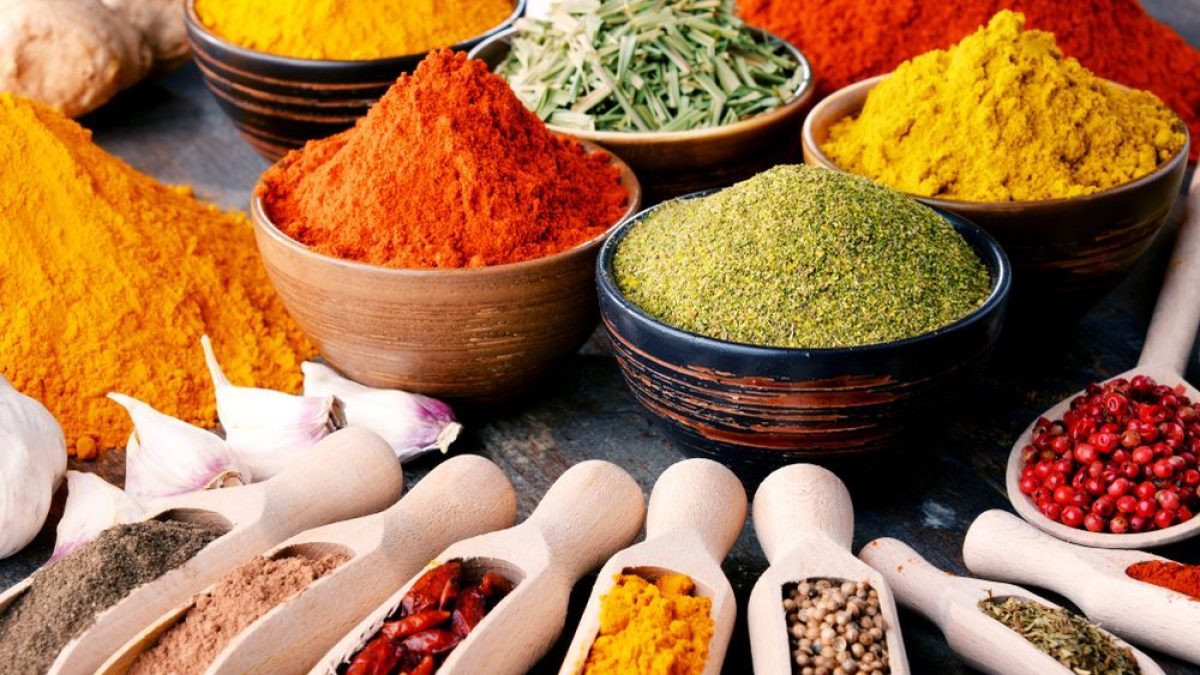
Spices have accompanied man since ancient times, giving rise to legendary trade routes and influencing the history and culture of entire civilizations. Those colorful powders, or seeds with a thousand shades, have always been a fundamental element of cuisine: from the exotic aromas of the East to the bold flavors of the Mediterranean, spices have the power to transform a simple dish into an unforgettable culinary experience.
Today, spices are accessible to everyone, allowing us to experiment in the kitchen with surprising combinations and mixes. But what do we really know about spices? Where do they come from, and how are they best used? Let's embark on a journey to discover spices, their properties, but above all, the combinations that bring out their best and the dishes in which they can be used.
Differences Between Aromatic Herbs and Spices
Herbs and spices are often used interchangeably in cooking, but they actually have some significant differences. With aromatic herbs, the main parts used are the leaves, but also the flowers and shoots, either fresh or sometimes dried. For this reason, aromatic herbs tend to have a more delicate and fresh flavor and aroma, often with citrus or herbaceous notes. Generally, though not necessarily, they are added at the end of cooking to enhance the flavor of the dish.
The word spices, on the other hand, always refers to herbs, but they are used in various parts, such as seeds, fruits, roots, bark, buds, or other parts of the plant, almost always dried. Spices tend to have a more intense and complex flavor and aroma, sometimes verging on the spicy. They are added during cooking to flavor dishes. Of course, this is a rough classification, and in the list you'll find products that are considered spices, but in some cases also herbs.

The Spice Supply to Always Have Available
Naturally, the use of certain aromatic spices is tied to a place's specific gastronomic culture and its biodiversity: just as aromatic herbs such as basil, thyme, and bay leaves are prominent in Mediterranean cuisine, other spices come from different contexts and were imported here through travel and migration. These include turmeric, coriander, cumin, ginger, cardamom, and chili pepper, which come from Indian, Pakistani, and Bengali cuisine; and ginger, cinnamon, cloves, and star anise, which come from Chinese cuisine, where chili pepper is also widely used. Other spices such as fennel seeds, dill, and cumin are more commonly used in Nordic cuisine, although cumin, along with chili pepper and paprika, is also common in Mexican cuisine. Ginger, cinnamon, and cardamom—although originally from India—are widely used in African cuisine, particularly in the Maghreb.
Spice blends, such as curry, garam masala, or berbere, are another matter entirely: they are simply mixes of several spices, the flavor of which can vary depending on the individual components. Let's analyze in detail the most useful spices to have at home, along with their preferred combinations and the benefits they provide.
Black, Green and Pink Pepper
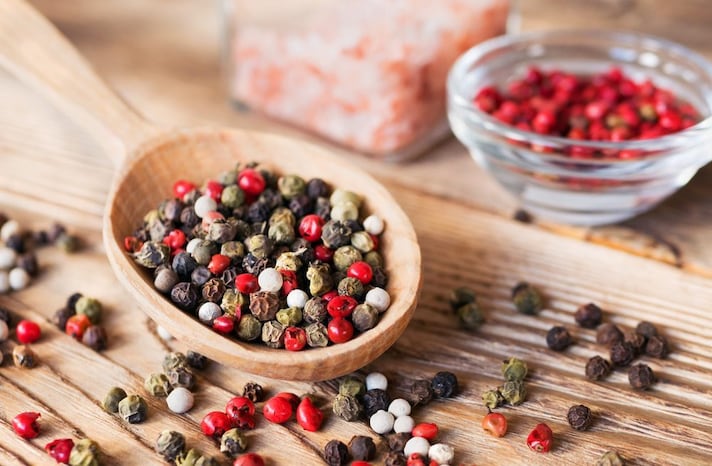
The world of peppers is a diverse one: the best-known varieties are black pepper, one of the most common and versatile spices in the world, with a complex and unmistakable aromatic profile, green pepper, and pink pepper. Green and black pepper come from the same plant, Piper nigrum, but are harvested at different stages of their ripening cycle: black pepper is harvested when the fruits are fully ripe and then dried in the sun, while green pepper is harvested when still unripe and subjected to a more rapid drying process. Pink pepper, on the other hand, is not a true pepper, but a fruit from a different plant, Schinus molle. It is harvested when ripe and has a bright pink color. It has an intense, slightly spicy and slightly bitter flavor, with citrus and spicy notes.
Piperine is the compound responsible for the spicy taste and many of the beneficial properties of pepper, and is more developed in the ripe fruit, therefore black pepper: it is able to stimulate the production of gastric juices, aiding digestion and, at the same time, increases body temperature, promoting sweating and purification.
Black pepper enhances the flavor of red meats like beef, pork, and lamb, or white meats like turkey and chicken: it's a must-have ingredient in saltimbocca alla romana, for example; it also pairs well with bold-flavored fish like salmon, tuna, and swordfish, as well as grilled vegetables. Many main dishes are enhanced by this ingredient, such as carbonara or cacio e pepe, for which the spice is essential.
Green pepper is perfect with white meats, but also with red meats, as in the recipe for peppercorn steak, a classic of international cuisine. Its delicate, citrusy flavor makes it ideal for white fish, such as cod or sea bass, or vegetables like asparagus, zucchini, and peppers. It's excellent for making creamy, delicate sauces, such as Béarnaise sauce(which sometimes uses another variant, white pepper, an even less ripe version of green pepper).
Pink peppercorn also pairs well with white and red meats: it's ideal for marinating chicken or flavoring a beef fillet. Its delicate, fruity flavor makes it ideal for accompanying raw fish, such as salmon or tuna carpaccio, and it also pairs well with sweet, delicate vegetables, such as carrots and fennel. Its citrusy notes make it ideal for desserts, such as mousses, creams, and ice creams, for flavoring fruit salads, or for making original jams and preserves.
Sweet, Strong and Smoked Paprika
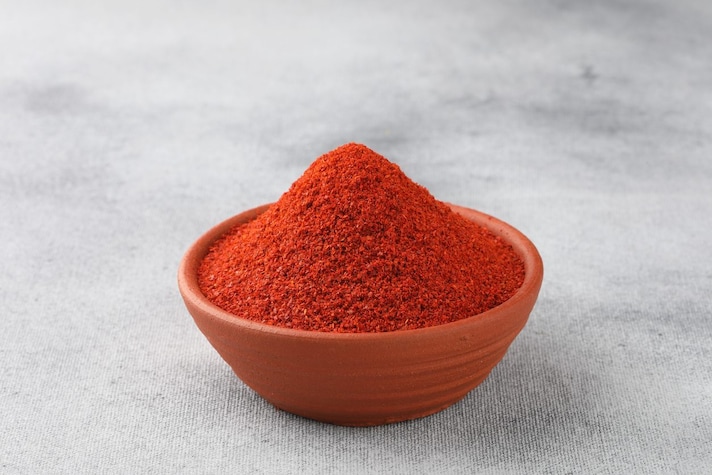
Paprika is a spice obtained by grinding dried peppers. Depending on the pepper variety used and the drying process, paprikas with different organoleptic characteristics and colors are obtained. It originated in South America, but is now cultivated in many parts of the world, particularly Hungary, Spain, and Mexico. Sweet paprika is made from sweet red peppers and has a deep red color and a delicate flavor: it is the most widely used in cooking. Smoked paprika is made by drying the peppers over a wood fire, which gives it an intense smoky aroma, while hot paprika is made from chili peppers and therefore has a more intense flavor and a color ranging from red to dark brown.
This spice is rich in vitamins (especially C, but also A and B vitamins) and is a good source of iron, potassium, and magnesium, essential for many bodily functions. Thanks to the presence of carotenoids, paprika has antioxidant properties that help fight free radicals and prevent cellular aging.
Its culinary uses vary depending on the dish being prepared: for example, sweet paprika is ideal for flavoring meat, egg, and vegetable dishes, as well as sauces, soups, and stews. Smoked paprika is ideal for red meats, sausages, and beans, lending a smoky, intense flavor: goulash is one of the most famous examples of paprika-based dishes. Finally, hot paprika, perfect for those who love bold flavors, is excellent for marinating meats, preparing spicy sauces, and flavoring hot dishes.
Turmeric
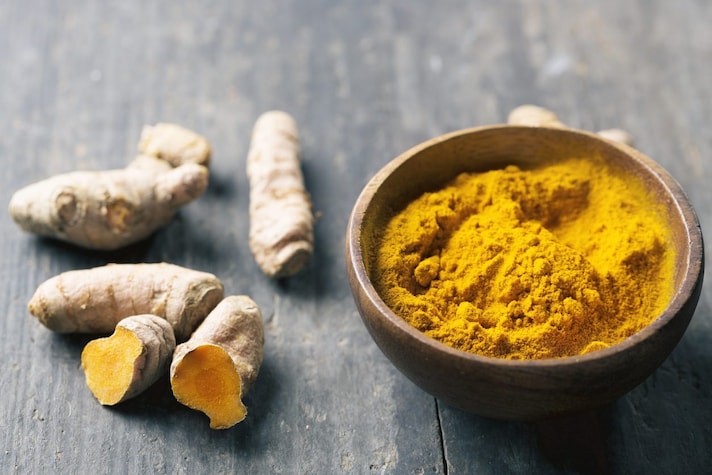
Turmeric comes from the root of the plant of the same name, a member of the Zingiberaceae family, like ginger. Native to India and Southeast Asia, turmeric has long been used in traditional cuisine in these regions. The part used is the rhizome, a sort of fleshy, branched root, which, when dried and ground, yields the yellow spice we know. Renowned for its beneficial properties, thanks to the presence of curcumin, a substance with important antioxidant and anti-inflammatory properties, turmeric stimulates bile production, aiding digestion and can help improve memory and cognitive function.
Turmeric is a very versatile spice, used in both sweet and savory dishes, thanks to its slightly spicy and bitter flavor, which enriches dishes with aromatic notes. In Indian cuisine, it is one of the most used spices: it is a fundamental ingredient in curry, understood as a spice mix, but also in Thai curry, understood as a dish. Turmeric pairs well with rice, fish, white meats and is excellent for flavoring legumes such as lentils, chickpeas, and beans; it also pairs well with other spices such as cumin, ginger, and coriander, or with garlic, which enhances its flavor; coconut milk is one of the ingredients most commonly used in combination with this brilliant spice.
Coriander
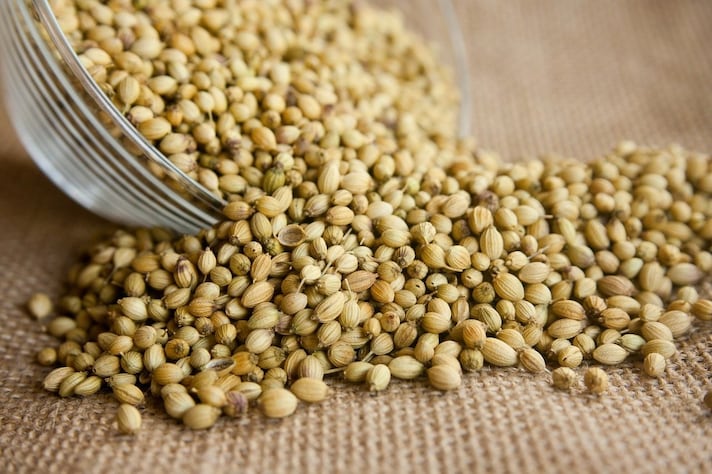
Coriander (Coriandrum sativum) is an annual plant belonging to the Apiaceae family: native to the Middle East, it is now cultivated throughout the world. Both the fresh leaves, with a citrusy, fresh flavor that visually resembles parsley, and the seeds, with a more intense, spicy aroma, are used. Known for its digestive properties, which help reduce bloating and abdominal cramps, it has anti-inflammatory properties that can relieve muscle and joint pain, as well as antibacterial properties that can help fight infections.
The combinations vary, depending on the part used:
- The leaves have a fresh, citrusy, slightly spicy flavor with notes reminiscent of lemon and orange peel: they are mainly used to flavor cold dishes such as salads, guacamole, various sauces, and fish dishes. They also pair beautifully with other aromatic herbs such as parsley and mint, as well as citrus fruits, garlic, and chili pepper.
- Dried coriander seeds have a more intense, earthy flavor than the leaves, with warm, spicy notes reminiscent of orange and lemon. They can be found whole or ground and are used to marinate meat and fish, and to flavor stews, soups, curries, breads, and baked goods. They pair well with cumin, ginger, cinnamon, cloves, and chili pepper, as well as garlic and olive oil. They are a key ingredient in Indian and Mexican cuisine.
Cumin
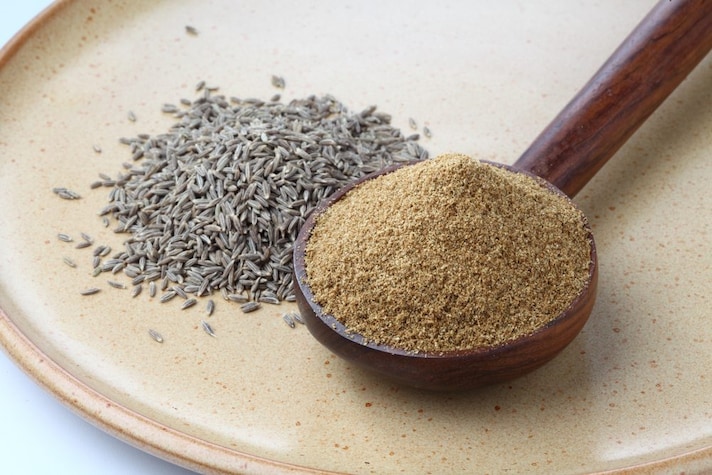
Cumin (Cuminum cyminum) is an annual herbaceous plant native to the Middle East, but is now cultivated in many parts of the world. Its brown seeds, slightly bitter and with a subtle citrus note, are used in cooking. A good source of iron, cumin stimulates the production of gastric juices, aiding digestion and relieving ailments such as bloating and cramps. It is widely used in Indian and Middle Eastern cuisine, as well as in Mexican cuisine (often used to flavor chili and fajitas).
Cumin pairs well with red meats, lamb, and poultry, and enhances the flavor of lentils, chickpeas, and beans. It's also excellent in dips, flavoring hummus, falafel , and other legume-based dishes. It's often used to flavor baked or sautéed vegetables, or to enrich bread, focaccia, crackers, and baked goods. Cumin also pairs well with garlic, which enhances its flavor, or with other spices like coriander, paprika, and ginger.
For a more intense aroma, lightly toast the cumin seeds in a nonstick pan before grinding them. If possible, grind the cumin seeds just before using them for a fresher, more intense flavor. Remember that cumin has a strong flavor, so use it sparingly.
Nutmeg
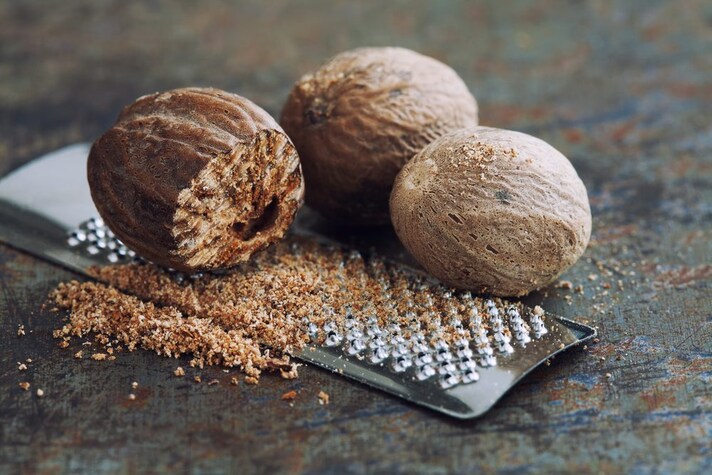
Nutmeg is obtained from the seed of an evergreen plant native to the Moluccas Islands in Indonesia: Myristica fragrans, a tree in the Myristicaceae family, now cultivated in intertropical zones. Two spices are obtained from this plant: the hulled seed, or nutmeg as we know it, and the outer layer covering the seed, which provides mace. The fruit is the most commonly used part: a peach-like drupe containing a seed that, once dried and grated, provides the precious spice.
Nutmeg is known for its carminative properties, meaning it helps reduce bloating and intestinal gas, aiding digestion. It has antibacterial properties that can help fight certain infections. In traditional medicine, nutmeg is considered a natural aphrodisiac: in very high doses, myristicin, a substance present in nutmeg, can cause hallucinations, nausea, dizziness, and palpitations. It has a strong flavor, so it's best to use it sparingly: for a more intense aroma, it's best to grind nutmeg just before use.
Nutmeg pairs well with a wide range of ingredients, both sweet and savory. Its warm, slightly spicy flavor makes it perfect for flavoring game, chicken, and pork, as well as vegetables like squash, spinach, and even mushrooms. It's perfect for adding a touch of spice to delicate, creamy dishes, such as béchamel sauce, mashed potatoes, and soups. It's often used in sponge cakes, biscuits, and sweet creams.
A classic pairing for nutmeg is with allspice, which we'll discuss later, and this blend is particularly popular in Caribbean and Latin American cuisines. The combination of nutmeg and allspice is perfect for marinating red meats, making barbecue sauces, roast sauces, and hot sauces, and adding depth and heat to soups and stews, especially those with legumes. Many spice blends, such as garam masala, contain both nutmeg and allspice.
Cinnamon
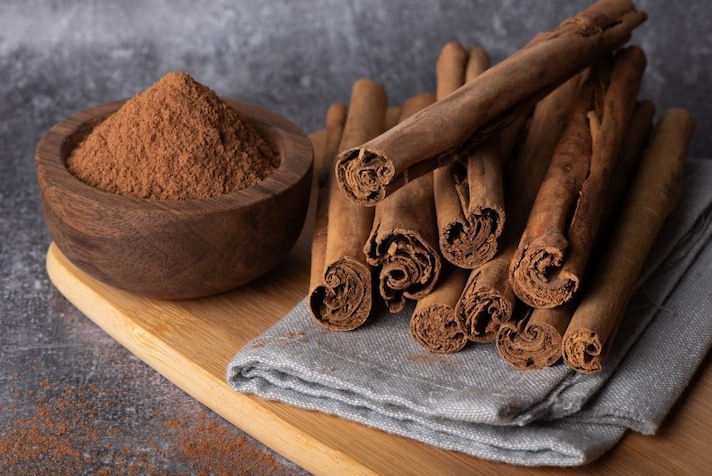
Cinnamon is extracted from the inner bark of certain tree species of the Cinnamomum genus, native mainly to Sri Lanka and China. There are two main varieties: Ceylon cinnamon, considered the best, has a sweet, delicate aroma with fruity notes, and Chinese cinnamon, which is cheaper and has a stronger, slightly bitter flavor. Known for its antibacterial properties, which help fight infections, cinnamon aids digestion and relieves gastrointestinal disorders.
Cinnamon has a warm and enveloping flavor: it is a spice widely used in desserts and alcoholic beverages. It pairs perfectly with ingredients such as apples, pears, bananas, raisins, and walnuts, as well as with spices such as cloves, ginger, and nutmeg. It is used to flavor mulled wine and some cocktails. As for savory dishes, cinnamon is used to flavor meats, especially red meats, stews, soups, and vegetable curries.
Cardamom
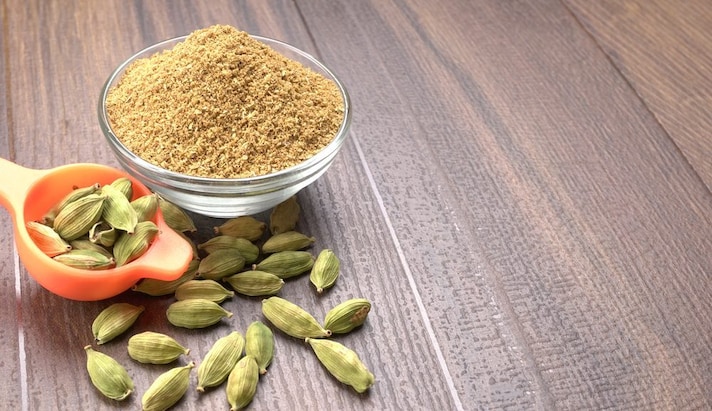
Cardamom is a spice derived from the seeds of some tropical plants in the Zingiberaceae family, the same family as ginger. The best-known varieties are green cardamom (Elettaria cardamomum) and black cardamom (Amomum subulatum). Green cardamom is considered the most valuable and is used primarily in Indian and Middle Eastern cuisine. It is a key ingredient in garam masala, a spice blend widely used in India; it is used to flavor curries, biryani, and other Indian specialties. Cardamom is present in many Middle Eastern dishes, such as tagines and couscous. It is a spice that helps stimulate digestion and relieve gastrointestinal disorders such as bloating and cramps, and has antibacterial properties that can help fight infections.
Cardamom has an intense and complex flavor, with citrus notes, slightly spicy but, at the same time, slightly sweet: the aroma is fresh and spicy, with hints of eucalyptus and lemon. It pairs well with white meats such as chicken and turkey, but also with red meats such as lamb. It is perfect for preparing marinades for fish, and enhances the flavor of vegetables such as pumpkin, carrots, and cauliflower. It pairs well with dried fruit, such as almonds and walnuts, and with fresh fruit such as apples and pears. It is often used to flavor fruit-based desserts, chocolate, and creams.
Cloves
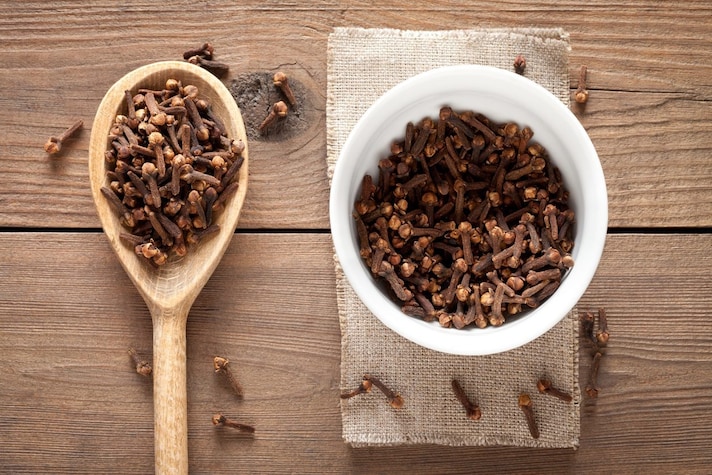
Cloves come from the dried flower buds of an evergreen tree belonging to the Myrtaceae family and native to the Moluccas, an Indonesian archipelago. Their name derives from their shape, which resembles a nail: they are dark brown in color, hard in texture, and have a warm and spicy aroma, with sweet and slightly spicy notes. Cloves possess anti-inflammatory properties that can help relieve muscle and joint pain. Thanks to the presence of eugenol, a substance with analgesic properties, cloves can help relieve toothache and other types of pain.
Cloves pair well with fruits such as apples, pears, oranges, and plums, and spices such as cinnamon, nutmeg, ginger, and cardamom. They can be used to flavor beef, pork, or lamb dishes, as well as legumes such as lentils and chickpeas. They are often used in punch, mulled wine, to flavor teas and herbal teas, or in the production of alcoholic beverages such as liqueurs or macerated drinks. They are a fundamental ingredient in the preparation of baked goods and spiced biscuits.
Ginger
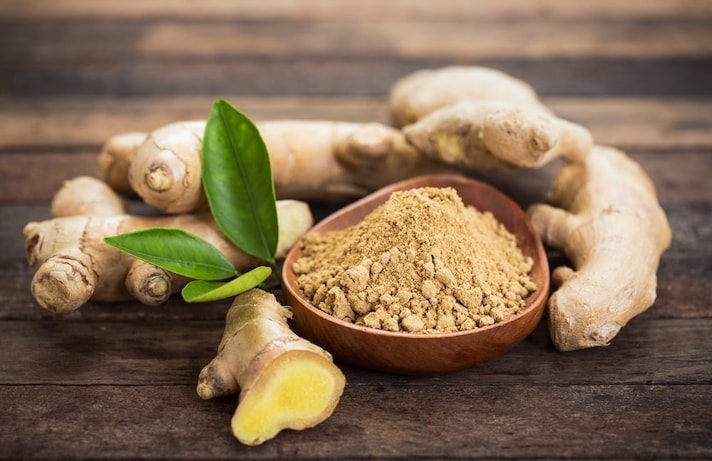
Ginger, Zingiber officinale, is a herbaceous plant of the Zingiberaceae family, native to the Far East. The part used in cooking is the rhizome, a fleshy, aromatic root with a yellow-ochre color. Its flavor is pungent, slightly spicy, and with citrus notes. It is known not only for its pungent, aromatic flavor, but also for its properties: it stimulates the production of gastric juices, aiding digestion and relieving ailments such as nausea, bloating, and indigestion. It helps relieve muscle and joint pain and strengthens the immune system.
Used both fresh and ground, ginger is probably the most versatile of the spices mentioned and lends itself to numerous sweet and savory preparations. It pairs very well with white meats like chicken and pork, but also with fish, to which it lends a fresh flavor. It's perfect for flavoring sautéed or stewed vegetables, such as carrots, zucchini, and cabbage, and for adding a touch of heat and spiciness to soups and broths. It's particularly used in sauces and chutneys, but also in desserts: it pairs beautifully with cinnamon and honey, creating desserts with a spicy and enveloping flavor. In desserts, it's often used to make original and delicious jams and marmalades, such as orange or apple jam, biscuits like the famous gingerbread, teas, and herbal teas. Also used in some cocktails, it's essential for making ginger ale, a non-alcoholic ginger-based drink, ideal for quenching thirst and aiding digestion.
Anise and Star Anise
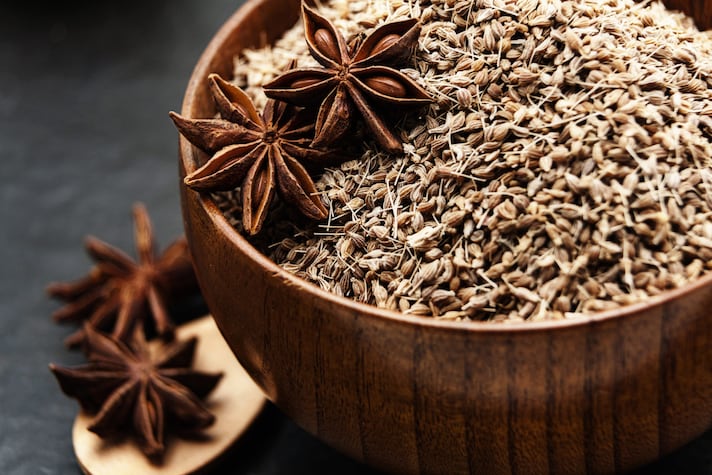
We have put them together for convenience, but anise and star anise, despite sharing a similar name, are two different spices with different organoleptic characteristics and uses in the kitchen.
Anise (Pimpinella anisum) is native to the eastern Mediterranean and is an annual herbaceous plant whose small, oval, light brown seeds are used. It has digestive, carminative (it promotes the elimination of intestinal gas) and balsamic properties, and is in fact used to relieve digestive disorders, coughs and sore throats. Anise has a sweet flavor, with notes of licorice and a slightly bitter aftertaste: it is used in various savory and sweet preparations, but also in traditional drinks. It is in fact a fundamental ingredient in the preparation of liqueurs such as sambuca and anisette, but also in bread, biscuits and desserts. It is also often used to flavor cheeses, meats and vegetables, and to flavor bread, desserts and fish-based dishes. Anise goes well with dried fruit, cinnamon, cardamom, vanilla and licorice.
Star anise (Illicium verum) is native to southern China: it is recognized by its characteristic star shape, from which it takes its name. It is a fundamental ingredient in Chinese, Indian, and Vietnamese cuisine. Star anise boasts antibacterial, antiviral, and digestive properties: it is used to relieve stomach pain and nausea. Its flavor is sweet, intense, and slightly spicy, with notes of licorice: it is mainly used in powdered form to flavor savory and sweet dishes, but can also be used whole, especially in drinks. It pairs well with cinnamon, cloves, cardamom, vanilla, and hot spices such as chili pepper. It is excellent for flavoring tea, coffee, desserts, and meat dishes.
Saffron
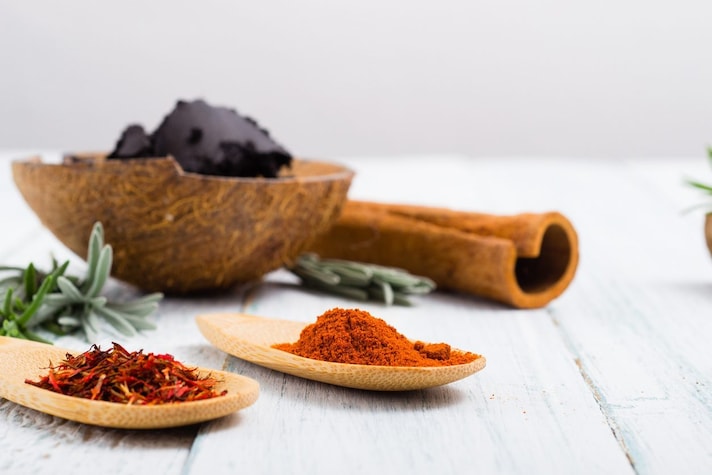
Probably the most loved and used spice in cuisine, saffron is also one of the most prized and expensive spices in the world, with an intense aroma and an unmistakable golden yellow color. It is obtained from the stigmas of the Crocus sativus flower, a plant of the Iridaceae family. Harvesting the stigmas is extremely laborious and manual work, which partly explains its high cost, as well as the fact that its production is biennial. Iran is the world's leading producer of saffron, but it is also grown in Spain, Greece , and Italy, where they have excellent productions, especially in Abruzzo. Saffron is rich in antioxidants, such as crocin, which has been shown to have anti-inflammatory properties: furthermore, it can help improve digestion and reduce gastrointestinal disorders.
Saffron has an intense, rounded, and aromatic flavor, with sweet yet slightly bitter notes: it pairs well with many ingredients, both sweet and savory. Saffron pairs well with delicate fish such as sea bass and bass, but also with equally delicate meats, such as chicken. Saffron can be used to flavor soups and vegetable creams, such as pumpkin soup, but also to flavor desserts, such as sponge cake or biscuits.
Saffron pairs well with dried fruit, such as almonds and pistachios, and with fresh fruit, such as oranges and lemons, and is often used to flavor fresh cheeses, such as ricotta or stracchino. You can add a pinch of saffron to milk, tea, or wine to create hot, flavored drinks.
Dill
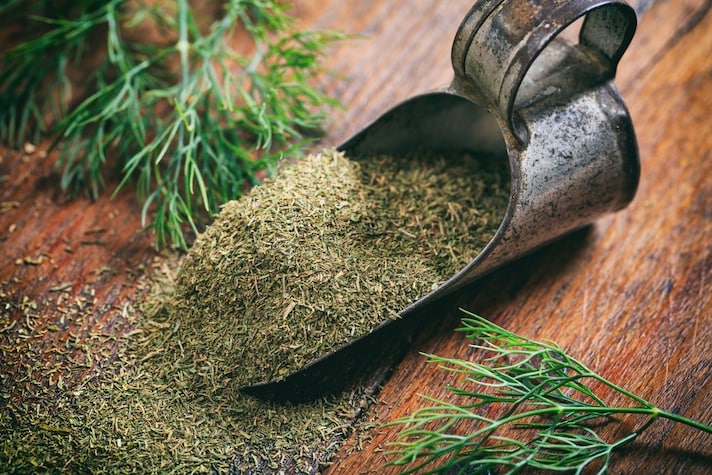
Native to southwest Asia, dill (Anethum graveolens) is an annual herb belonging to the Apiaceae family. It has adapted so well to the southern Mediterranean that it is considered a "naturalized exotic" plant. Historically considered a medicinal plant, dill aids digestion and relieves intestinal disorders such as bloating and cramps by stimulating the elimination of excess fluids. It also has a calming effect on the nervous system, helping reduce anxiety and stress.
Its thread-like leaves and small yellow flowers gathered in umbels make it easily recognizable: both the leaves and the dried seeds are used in cooking.
- Fresh leaves have a more delicate and fresh flavor: they are perfect for flavoring fish-based dishes, such as salmon and herring, and also go well with potatoes, eggs, fresh cheeses, and yogurt.
- The seeds have a more intense and slightly bitter aroma: they are often used to flavor bread, sauerkraut, pickles, marinades and liqueurs.
In general, dill is ideal for flavoring fish, especially fatty fish like salmon and herring, or even mackerel. It pairs well with fresh cheeses like ricotta or feta, but also with potatoes, or with vegetables like carrots, cucumbers, and onions. It can be used to marinate chicken or pork, in pickles or oil preserves, and even in fresh sauces like yogurt sauce or tzatziki.
Fennel Seeds
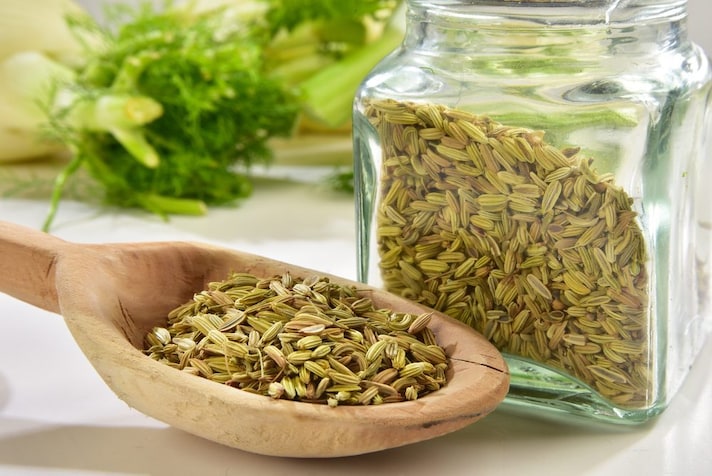
Fennel, Foeniculum vulgare, is a herbaceous plant belonging to the Apiaceae family, native to the Mediterranean basin. It is wild fennel, of which the shoots, leaves, flowers, and fruits, improperly called "seeds," are used. They are known for their digestive properties, which help relieve bloating and abdominal cramps, and promote the expulsion of intestinal gas, stimulating the diuretic effect.
The sweet, aniseed flavor of fennel seeds makes them versatile in the kitchen: a classic pairing is with fish, especially swordfish and salmon, but they also pair well with white meats like turkey or chicken. They're perfect for flavoring soups, broths, and legume stews, but they're especially used to flavor bread, breadsticks, and crackers. Fennel seeds have a unique flavor profile, making them ideal for desserts, such as cookies, cakes, and sweet breads.
Chili

We could already write a separate guide on chili peppers, given the many types found in nature and on the market. Native to Central and South America, chili peppers (Capsicum annuum) are now grown throughout the world. There are many varieties, over 250, which differ in shape, color, size, and level of spiciness, measured on a specific scale, the Scoville scale. Some of the most famous varieties are the jalapeño, the habanero, the cayenne pepper, and the Tabasco chili pepper, from which the famous Mexican sauce takes its name. There are entire cuisines based on this spice, such as Mexican, Korean, and many African cuisines.
Chili peppers are rich in vitamin C, a powerful antioxidant that helps strengthen the immune system. They also contain capsaicin, the substance responsible for spiciness, which has several beneficial properties, such as thermogenic effects (increasing body temperature, helping burn calories), analgesic effects, and antioxidant effects.
Chili pepper, whether fresh or ground, is a very versatile spice and adapts to a wide range of dishes. It is used in many pasta sauces, such as arrabbiata, but also in red and white meat dishes, such as beef, pork, and chicken. It adds a spicy touch to soups and legume stews, or to baked or grilled vegetables. Naturally, chili pepper is the main ingredient in many hot sauces, such as Tabasco sauce and harissa, and in various spice mixes such as berbere. Excellent on pizzas with other spicy ingredients, such as diavola, it can be used in oil or vinegar preserves, where it sometimes takes center stage. It pairs well with many other flavorings, such as garlic, oregano, cumin, and coriander.
Allspice
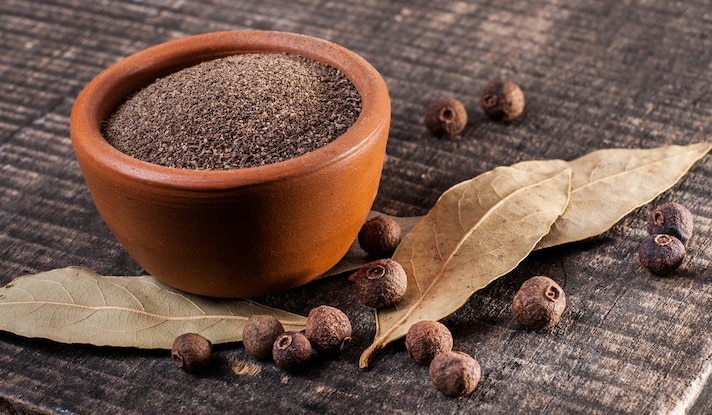
Allspice, also known as Jamaican pepper or pimento, is a complex spice with many facets and an unmistakable aroma. It is the fruit of Pimenta dioica, an evergreen tree native to the West Indies: the spice is obtained from its unripe fruits, which are dried and ground. Its name, allspice, comes from the English and means "all spices," as its flavor is reminiscent of a mix of cinnamon, nutmeg, cloves, and pepper.
Allspice boasts many benefits: it stimulates the production of gastric juices, aiding digestion and relieving discomforts such as bloating and cramps. It has antibacterial and antiseptic properties, useful for fighting infections, and anti-inflammatory properties, which help relieve muscle and joint pain.
As we mentioned, its flavor is complex, which is probably why it isn't widely used in Mediterranean cuisine. However, it is an ideal spice for marinating red and white meats, giving them an intense, spicy aroma: it pairs particularly well with chicken, pork, and lamb. A classic of Jamaican cuisine is jerk chicken, a preparation of chicken marinated in a spicy sauce made with allspice, chili pepper, and other herbs.
Allspice is excellent for flavoring fish soups and marinades for baked or grilled fish, legume and vegetable stews. It's also a key ingredient in barbecue sauces, curries, and marinades, and pairs well with other herbs and spices, such as bay leaves, thyme, and rosemary, as well as with dried fruit and chocolate.
;Resize,width=767;)
